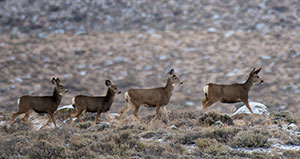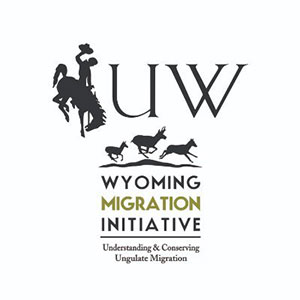UW Donor-Funded Fellowship Supports Wyoming Migration Initiative
Published August 05, 2022

Before her death, Diane Mott knew she wanted to do two things: to honor her parents and to do her part to protect Wyoming’s landscapes. So, she gave a major estate gift to establish the Harold and Jean Mott Fellowship in Migration and Conservation at the University of Wyoming.
“I am donating to establish a fellowship in their name because of their love of Wyoming, in whose open lands, crisp rarefied air, magnificent landscapes and wildness they found sustenance, and because of my abiding gratitude for having grown up there,” Mott said before she died in April 2020. “Now, as I approach the end of my life, I want to do what I can to protect Wyoming’s greatest assets -- its wilderness and wildlife -- as ‘civilization’ encroaches on, alters and erodes them. I would like future generations to be able to draw peace, enjoyment and sustenance from Wyoming’s incomparable beauty just as my parents and I were able to do.”
The Harold and Jean Mott Fellowship in Migration and Conservation will support the Wyoming Migration Initiative, a UW-based collaborative of biologists, photographers, cartographers and writers working to research ungulate migration and share that information with the public.
Mott was born in Oklahoma City to Harold and Jean Mott but, shortly thereafter, she and her family moved to Casper, where she spent her childhood. It was in Casper that she developed a deep love for Wyoming’s natural beauty.
However, Mott moved away from Wyoming to earn a bachelor’s degree from the University of Michigan. Most of her adult life was spent outside of Wyoming, with her work taking her all over the world. She spent much of her time in Turkey, as well as in Atlanta and San Francisco.
Mott volunteered for the Peace Corps in 1970 and spent two years in eastern Turkey. She then worked with historic textiles for the Atlanta Historical Society. Then, as a Fulbright Scholar, Mott returned to Istanbul, working at the Topkapi Palace Museum studying Ottoman court textile production while working on her doctorate.
She returned to Atlanta as a postdoctoral student to pursue a Master of Fine Arts under the direction of renowned weaver Greg Kaufman at the University of Georgia. To support her studies, she worked at the Centers for Disease Control and Prevention. She then worked at the Museum of Fine Arts in Boston and at the M.H. de Young Memorial Museum in San Francisco, retiring in 2009.
Mott inherited her love of textiles from her mother, who owned the Spinning Wheel yarn and needlework store in Casper.
Even with all of her world travels, Mott never lost her Wyoming roots. She considered wilderness and wildlife to be Wyoming’s greatest assets, and she wanted to help protect these assets from development and destruction.
Mott felt it was incredibly important to help preserve the great Wyoming landscape so that future generations could enjoy its peace, tranquility and beauty -- just as she once had. Additionally, she wanted to honor her parents in the state they loved.
Mott noted, in an interview, that her father enjoyed spending time in the wilderness with friends as he fished and occasionally hunted. Her mother was of Cherokee descent and, from this, Mott drew a profound reverence for the earth and its beings and had a desire to protect it.
Mott said of her parents, “Each, in their own way, loved Wyoming’s nature, its beauty and majesty. As part of his job, Harold Mott crisscrossed the state in pursuit of leases and had many stories to tell about the people and places he encountered along the way. He enjoyed packing into the wilderness with friends and colleagues to fish and occasionally hunt.
“Jean, too, loved to be outdoors but in a gentler way. Informed by her Cherokee heritage, she had a reverence for the earth and all that it encompasses and a deep desire to safeguard it.”

The mission of the Wyoming Migration Initiative is to advance the understanding, appreciation and conservation of Wyoming’s migratory ungulates by conducting innovative research and sharing scientific information through public outreach. The initiative hopes to help solve some of the largest issues facing big-game animals in the Rocky Mountain region.
The initiative supports projects such as the Interstate 80 Wildlife Barrier Project, which looks to solve the disruption I-80 causes to the migration of big-game animals in Wyoming and the northern Rocky Mountains. This disruption has proven to be one of the most significant large-scale conservation opportunities in the American West.
“This generous gift will allow us to establish a graduate fellowship to support promising students to come to the University of Wyoming, to study migrations and to contribute to conserving wild migration and wild lands that were so important to the Motts’ sense of Wyoming,” says Matt Kauffman, director of the Wyoming Migration Initiative.
The initiative is well known for its focus on mapping of migrations and associated cartography. For example, working with their longtime collaborators at the Wyoming Game and Fish Department, Wyoming Migration Initiative researchers and graduate students conducted the Eastern Greater Yellowstone Mule Deer Project, which mapped the migration corridors of five mule deer herds in the eastern portion of the greater Yellowstone ecosystem. This mapping has allowed the Wyoming Game and Fish Department to better manage the corridors and groups such as The Nature Conservancy to modify fences to ease passage of migrating mule deer.
The initiative also is working with the Eastern Shoshone and Northern Arapaho Department of Fish and Game and the U.S. Fish and Wildlife Service to map mule deer and elk migrations on the Wind River Indian Reservation. Their studies show that two mule deer herds winter on the intact landscape of the reservation before moving up to 100 miles to the west to seek out better forage in their mountain summer ranges. Detailed migration maps from the project are guiding fence removal, weed treatment and other efforts to enhance wildlife habitats on the reservation.
In addition to research, the initiative works to increase public knowledge and awareness of Wyoming’s wildlife migrations, the threats they face and ongoing conservation efforts to conserve them. The initiative does this through map animations, photography and numerous viral videos shared through social media that show the beauty and challenges of ungulate migrations across the state.
The Wyoming Migration Initiative can be found online at www.migrationinitiative.org, www.facebook.com/migrationinitiative, https://x.com/wyo_migrations and www.instagram.com/migrationinitiative/.
Mott’s support for the Wyoming Migration Initiative was established through a planned estate gift. A planned estate gift is a gift that is planned in advance of a person’s passing, and it goes on to benefit the area of the donor’s choice upon a person’s passing. Such gifts have had a large impact on the future of UW.
For questions about planned giving and estate gifts, or to include UW in your will, call Brett Befus at the UW Foundation at (307) 766-4259 or email bbefus@uwyo.edu.

